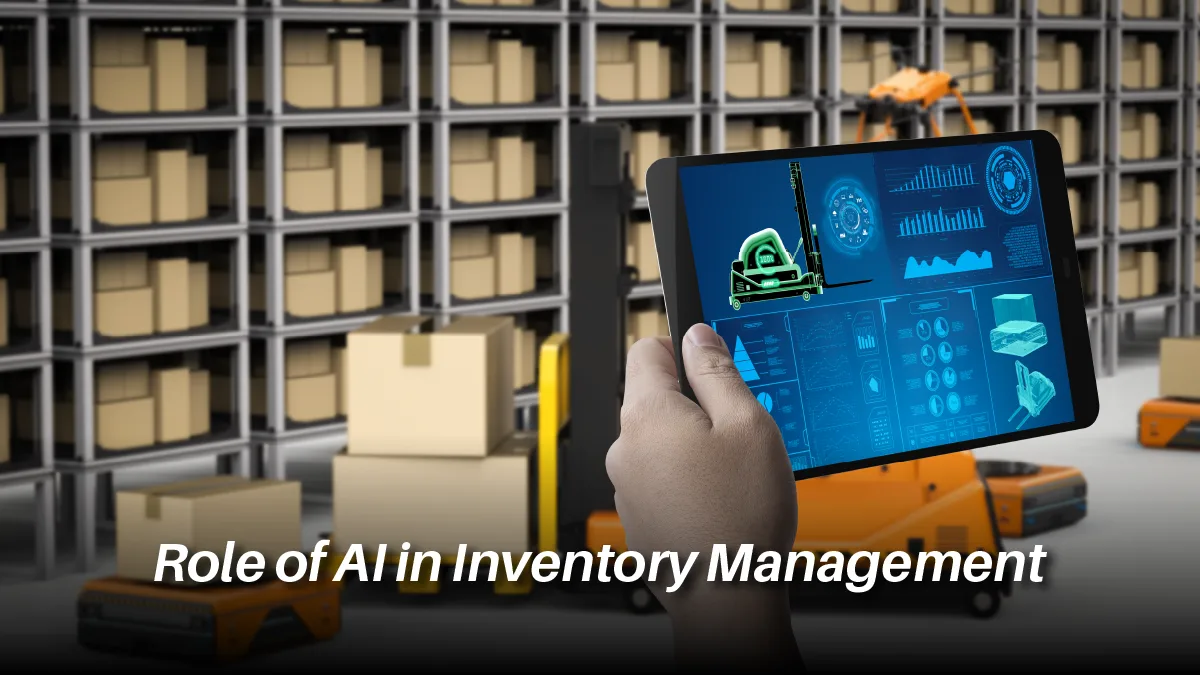Artificial Intelligence (AI) is revolutionizing inventory management by integrating advanced technologies. This article explores what AI inventory management entails, its benefits, and how it optimizes inventory levels, improves customer satisfaction, and enables businesses to make informed decisions through accurate demand forecasting. AI-driven insights can help companies anticipate market trends. They can then adjust their strategies, leading to more agile operations. Additionally, the automation of routine tasks reduces human error and frees up employees to focus on other important tasks. As businesses increasingly adopt AI technologies, they position themselves to not only meet current demands but also adapt to future challenges in the ever-evolving marketplace.
What is AI Inventory Management?
AI inventory management refers to the application of AI technologies to automate and optimize the processes involved in managing inventory. This includes tracking stock levels, predicting future demand, and automating replenishment tasks. By leveraging vast amounts of data, AI systems can analyze historical sales patterns, market trends, and external factors to make accurate predictions about inventory needs. This proactive approach helps businesses maintain optimal stock levels while minimizing costs associated with overstocking or stockouts.
Limitations of Traditional Inventory Management
 Traditional inventory management relies heavily on manual processes and historical data analysis. While these methods have served businesses for decades, they come with significant limitations that can hinder efficiency and responsiveness in today’s fast-paced market:
Traditional inventory management relies heavily on manual processes and historical data analysis. While these methods have served businesses for decades, they come with significant limitations that can hinder efficiency and responsiveness in today’s fast-paced market:
Time-consuming Processes: Businesses often rely on spreadsheets, paper records, or basic software to manage their inventory levels. This labor-intensive approach requires employees to dedicate significant time to counting stock, updating records, and placing orders. The manual entry of data is not only tedious but also increases the likelihood of errors.
Inaccurate Data: Many businesses conduct periodic inventory counts rather than real-time tracking. This practice can result in inaccurate data, as stock levels may change rapidly. Relying on outdated information can lead to poor decision-making regarding stock replenishment. This may lead to missed sales opportunities or excess inventory that ties up capital and incurs storage costs.
Limited Visibility: Traditional inventory systems often lack real-time visibility. This makes it difficult for businesses to respond quickly to changes in demand. Companies may struggle to identify trends or shifts in consumer preferences. This limited visibility can hinder decision-making. It can prevent businesses from optimizing their stock levels in response to market changes.
High Carrying Costs: Businesses using traditional methods often struggle to maintain excess inventory. High carrying costs associated with overstocking—including storage expenses, insurance, and potential obsolescence—can significantly impact profitability. Companies may invest too much in holding inventory than necessary, diverting funds from other critical areas of the business.
Businesses can overcome these limitations through the implementation of AI technologies. This will help them transform their inventory management processes into more streamlined operations. As consumer expectations evolve, businesses must adapt their inventory management strategies.
Role of AI in Inventory Management

Improved Demand Forecasting
One of the most significant advantages of implementing AI in inventory management is its ability to provide accurate demand forecasting. Traditional inventory management often relies on historical data and intuition, leading to inaccuracies. In contrast, AI employs machine learning (ML) algorithms that analyze historical sales data alongside current market conditions to predict future demand more effectively. This capability allows businesses to adjust their inventory levels based on anticipated customer needs, reducing the risk of excess stock or shortages.
Real-time Data Analysis
AI-powered inventory management systems utilize real-time data from various sources. This includes sales transactions, supply chain information, and social media trends. This real-time analysis enables businesses to respond swiftly to changes in consumer behavior or market conditions. For instance, if a sudden spike in demand for a particular product occurs, AI systems can automatically adjust inventory levels or trigger reorders to ensure the availability of products.
Optimizing Inventory Levels
Through continuous monitoring and analysis of real-time data, AI can optimize inventory levels by determining the ideal reorder points and safety stock levels for each product. This optimization minimizes carrying costs while ensuring the availability of sufficient stock to meet customer demand. This helps businesses improve their operational efficiency and profitability.
Enhanced Decision-Making
AI provides valuable insights that empower businesses to make informed decisions regarding their inventory management processes. By analyzing patterns within vast datasets, AI can identify inefficiencies and suggest improvements in supply chain operations. This allows companies to allocate resources effectively, streamline workflows, and enhance overall performance.
Automation of Manual Tasks
Implementing AI in inventory management reduces the time spent on manual tasks such as data entry and inventory tracking. Traditional methods often involve labor-intensive processes that are prone to errors. AI systems automate these tasks through integration with sensors and IoT devices. This helps businesses focus on more strategic activities that add value to their operations.
Also Read: Agile Supply Chain: The Key to Thriving in a Dynamic Market
Benefits of Implementing AI in Inventory Management
The integration of AI into inventory management systems offers several advantages:
Cost-effectiveness – AI helps companies lower their overall operational costs. This is achieved by optimizing inventory levels and reducing the need for excess storage space. Accurate demand forecasting minimizes waste associated with overstocked items while ensuring the availability of popular products for customers.
Improved Customer Satisfaction – In today’s fast-paced market environment, customer expectations are higher than ever. With accurate demand forecasting and real-time monitoring capabilities provided by AI, businesses can ensure that products are readily available when customers want them. This reliability enhances customer satisfaction and fosters brand loyalty.
Increased Efficiency – AI-driven automation streamlines various aspects of inventory management processes, leading to increased efficiency across the supply chain. By reducing manual errors and optimizing workflows, companies can allocate resources effectively and improve overall productivity.
Enhanced Supply Chain Visibility – AI enhances visibility across the supply chain by providing real-time insights into inventory levels and shipment status. This enables businesses to manage risks and respond quickly to disruptions or changes in demand.
Better Resource Allocation – With accurate data-driven insights at their disposal, businesses can allocate resources strategically across their operations. Whether it involves adjusting staffing levels during peak seasons or reallocating budget resources for marketing efforts based on predicted sales trends, informed decision-making leads to better outcomes.
Real-life Examples of Successful AI Implementation in Inventory Management
To illustrate the practical benefits of implementing AI in inventory management, let’s explore some real-life examples from various industries:
Example 1: Walmart’s Use of Predictive Analytics
Walmart uses advanced predictive analytics powered by ML algorithms to optimize its vast supply chain operations. It analyzes historical sales data alongside external variables such as weather patterns or local events. This helps Walmart to anticipate fluctuations in product demand across all its stores. Such a proactive approach enables it to maintain optimal stock levels and reduce waste associated with perishable goods.
Example 2: Amazon’s Automated Fulfillment Centers
Amazon has revolutionized e-commerce logistics through its automated fulfillment centers. These centers are equipped with sophisticated robotics guided by AI algorithms. They track item availability in real time while optimizing picking routes within warehouses based on current order volumes. This results in faster delivery times for customers while minimizing operational costs associated with labor-intensive processes.
Example 3: Coca-Cola’s Smart Vending Machines
Coca-Cola has launched smart vending machines. They use IoT sensors and ML to stock products based on consumer preferences in urban areas worldwide. This ensures the availability of popular beverages while reducing excess stock waste.
Conclusion
In conclusion, integrating AI into inventory management is important for businesses seeking to thrive in today’s competitive landscape. Traditional inventory methods are inadequate, leading to inefficiencies, high carrying costs, and poor decision-making. AI transforms inventory management by automating tracking, optimizing stock levels, and enhancing demand forecasting through real-time data analysis. This improves operational efficiency and boosts customer satisfaction.
Businesses that embrace AI will be better positioned for success in a fast-paced environment. Ultimately, adopting AI is not just a technological upgrade; it is a strategic necessity for long-term growth. Companies must leverage these advanced technologies to transform their inventory practices and maintain a competitive edge in the market. By doing so, they can optimize their operations and ensure that they meet the demands of modern consumers effectively.




